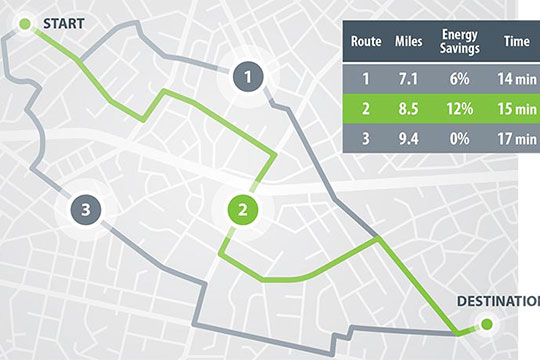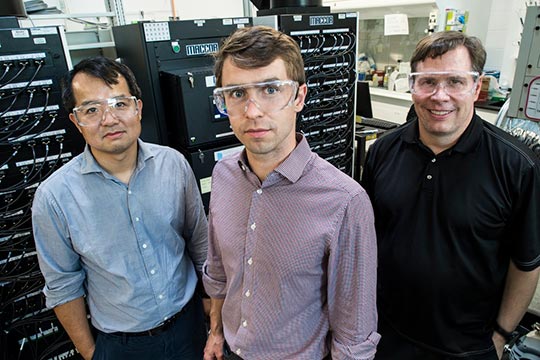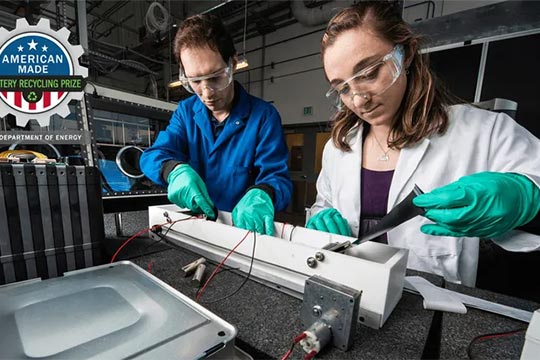Sustainable Mobility Matters—Spring 2021
This quarterly newsletter highlights recent projects, partnerships, and publications related to NREL's sustainable mobility research.
Subscribe to receive this newsletter via email.

Electric Vehicles Have Come of Age, Nourished by NREL's Research Legacy
NREL offers essential technical ingredients to support the rapid rise of electric vehicles across the country.
Perhaps you've seen the news: electric vehicles (EVs) are on the cusp of transforming the transportation marketplace as we know it. E-commerce giants have thousands of electric delivery trucks on order. Established automakers and vehicle startups are releasing new EV models every month. The Biden administration has voiced clear goals for a fully electric federal fleet—some 650,000 strong.
These developments attest to the rapid rise and promise of EV technology to help cut costs, fight climate change, and enhance mobility equity.
Like well-risen dough ready for the oven, EVs have come of age.
For example, we rigorously evaluate and refine electric components and batteries to improve the durability and range of EVs—both big and small. Our research on integrating smart charging technologies aids seamless EV-grid connections, refined by shrewd electric demand analysis, which could help accelerate the addition of renewables to the grid. Curated software and systems create strong defenses against cyberattacks. Not least, NREL experts support cities, communities, and businesses from coast to coast in deploying and realizing the benefits of EV technologies.
NREL has long watched the rise of EVs—but not from the sidelines. Our transportation and mobility research continues to overcome targeted technical challenges to ensure a level rise and an even better bake.
Drive on,
Chris Gearhart
Director, NREL's Center for Integrated Mobility Sciences

Lighting the Path to Net Zero: NREL's Strategy Drives Deep Transportation Decarbonization
Swiftly driving down carbon emissions in the transportation sector—the largest source of greenhouse gases in the United States—is critical in the push to avoid the worst impacts of climate change. To light the path to net zero, NREL released a comprehensive vision for decarbonizing transportation across all sectors, from passenger cars to commercial trucks, aircraft, marine, rail, and mobility systems. NREL's whole-system strategy considers these sectors as part of a larger energy ecosystem powered by renewable electrons and linked by low-carbon energy carriers.

How To Electrify the Entire Federal Vehicle Fleet: NREL Fuels Smart Management with Data-Driven Research
With the Biden administration announcing intentions to electrify the entire federal fleet, NREL's work supporting energy-savvy fleet management is more critical and timely than ever. NREL's Federal Fleet Project helps agencies plan vehicle acquisitions with data-driven decision-making. By filling in missing data gaps, supplying helpful resources on electrification, analyzing charging needs, and more, NREL not only serves federal fleets preparing for EVs but also may actually shape automaker decision-making as they continue to expand EV offerings.

Google Taps NREL Expertise To Incorporate Energy Optimization into Google Maps Route Guidance
To take a bite out of transportation energy use and emissions, NREL is partnering with Google to develop more eco-friendly routing in Google Maps. This work leverages a foundation of NREL-developed modeling and analysis tools such as the Route Energy Prediction Model, an energy-optimal routing and navigation platform that can predict the energy consumption of a given vehicle over a proposed route. Google plans to launch its eco-friendly routes option in the United States later this year, with eventual global expansion.

Mobility Behavioral Research Examines the Human Side of Transportation
NREL's mobility behavioral science research intertwines social science methodologies with traditional research efforts—bringing humanistic aspects of energy, policy, mobility access, and climate justice to the table. Expanding the sociocultural, economic, and behavioral facets of research projects makes the outcomes more innovative, inclusive, and successful. This novel approach improves the collective understanding of how people will respond to technology transitions and dynamic new mobility service offerings across spatial and temporal scales in diverse and varied communities across the nation. Learn more through the related mobility behavioral scientist article and video.
Scientists Announce Fast-Track Solution for Net-Zero-Carbon Sustainable Aviation Fuel
With 2050 jet fuel demand expected to be double pre-pandemic levels and airlines ramping up pledges to reduce emissions, innovations in aircraft fuels and engines are critical to closing the gap to net-zero greenhouse gas emissions. That task just got a burst of energy with the publication of a paper on carbon-negative sustainable aviation fuel by NREL scientists and partners. Using the untapped energy of wet waste, the groundbreaking biorefining process is already drawing attention from industry partners such as Southwest Airlines and others working to decarbonize flight.

Physics-Based Machine Learning Advances Battery Design
NREL scientists are turning to machine learning and artificial intelligence to change the way we understand advanced battery materials, chemistries, and cell designs. Researchers can use these cutting-edge techniques to evaluate manufacturing quality, lifetime and performance, materials research, and safety protocols for energy storage applications. A recent NREL-hosted Machine Learning and Batteries workshop provided a global forum for leading researchers in the field across national laboratories, academia, and industry to discuss how machine learning can accelerate development of advanced lithium-based batteries.
New Consortium Amplifies Silicon Anode Potential
A new NREL-led multi-lab Silicon Consortium Project addresses critical barriers to the development of smaller, cheaper, and better-performing lithium-ion batteries for electric vehicles by investigating the use of silicon as an alternative to graphitic carbon anode material. This initiative focuses on understanding the formation and evolution of the solid-electrolyte interphase to solve the calendar-life challenge—or the number of years a battery is expected to last—currently limiting the development of silicon anodes.

Using Mathematical Models To Enable Transportation Decarbonization
Researchers developed a simplified methodology for assessing the electrification potential of transit fleets as part of a related study in two Mexican cities. The publication detailing their study—coupling easily accessible GPS speed traces with an electric bus model—earned a "best paper" award at the IEEE Transportation Electrification Conference. Because GPS data are nearly universal, the tools used in this research can inform decisions about electrifying transit buses at scale across the globe. Transit electrification is a key strategy for ensuring that technologies that reduce emissions also enable greater access to mobility services.

Lithium-Ion Battery Recycling Prize Officially Launches Phase III
The U.S. Department of Energy (DOE) recently launched the third and final phase of the Lithium-Ion Battery Recycling Prize with a virtual kickoff event to introduce the Phase III rules and voucher guidelines. In Phase III, each team is expected to demonstrate its ability to recover lithium-ion batteries and verify the feasibility of achieving the end-to-end solution's projected impact when fully scaled. Up to four final winners of Phase III will receive up to $2,000,000, distributed equally among the winners.

Co-Optima Webinar Series Spotlights R&D for Cleaner, More Efficient Vehicles
Although EVs are coming off the assembly line in ever-growing numbers, petroleum-fueled vehicles with internal combustion engines will continue to make up a large share of the automotive market for years to come. What innovations can make these engines and fuels as environmentally friendly and energy efficient as possible? NREL scientists and others from DOE's Co-Optimization of Fuels & Engines (Co-Optima) initiative are tackling that question and others during DOE's six-part webinar series highlighting key takeaways from the breakthrough initiative.
Get To Know Our Team: Maggie Mann

A conversation with NREL's Maggie Mann, manager of NREL's mobility infrastructure and impacts analysis group and 2021 recipient of NREL’s Distinguished Member of Research Staff award, sheds light on the battery materials supply chain and the role that transportation plays in decarbonization.
What is your primary research focus at NREL?
Throughout my time at NREL, my analysis work has spanned various research arenas. Today I work in the rapidly evolving mobility and transportation area.
Recently, I spearheaded a project looking at the materials supply chain for manufacturing lithium-ion batteries for EVs, with a focus on resource availability and cost. This work supports President Biden's executive order encouraging domestic battery manufacturing and requiring a related supply chain review. A recent New York Times article in which I was quoted touched on the topic.
EV batteries depend on numerous materials, some of which are of particular interest due to their limited supply, potential supply-chain bottlenecks, and environmental concerns. Our analysis looked at the global flow of cobalt, nickel, and lithium through the trade of raw materials, chemical intermediates, manufactured components, finished products, and recycling. This work leveraged NREL's Lithium-Ion Battery Recycling Analysis (LIBRA) tool, a system dynamics model of the developing global and domestic lithium-ion battery manufacturing supply chain and recycling industry.
In your field of research, what one mobility challenge do we need to prioritize in the next five years?
It's critical that we prioritize mindful decarbonization. By that, I mean pursuing decarbonization strategies and infrastructure build-out in an efficient and cost-effective way while ensuring the solutions benefit everyone. In addition to our cost and carbon impact analyses and our resource assessments, environmental justice and social equity must be included at the forefront of our efforts so that we do not leave any groups behind or make them carry undue burden.
What sparked your interest in researching sustainable mobility?
I've always been an early adopter of sustainable technologies. I have photovoltaics on my roof and have subscribed to Xcel's Windsource program since its inception. I have also replaced and installed windows myself, heated my house with biomass for a while, and bought a Prius way back in 2003. When plug-in hybrid electric vehicles became available, I traded in my beloved Prius and bought my first plug-in hybrid. But it had a small battery, and I was frustrated by how little I could drive in all-electric mode. So after a few years, I bought an all-electric vehicle. It has been a fantastic car, and I doubt I will ever go back to a conventional gasoline vehicle.
My firsthand experience with vehicle performance, charging, and emissions tracking gave me a tangible feel for the challenges and joys of sustainable transportation. Since analysis is my forte, I love being able to integrate my personal experiences with sustainable technologies into the studies I conduct and lead at NREL.
Sustainable mobility is such an important topic. It presents one of the more difficult challenges in terms of decarbonization. I feel so blessed to work at NREL during this time of pivotal change in the energy and transportation sectors.
Why does sustainable mobility matter?
Mobility is a critical need for all humans, yet our current mobility systems and infrastructure have unacceptable health and environmental impacts, and their benefits are inequitably distributed. Sustainable mobility is critical for improving quality of life for people around the globe while addressing climate change challenges. EV charging enables us to cost-effectively take advantage of clean energy such as wind and solar—an imperative in mitigating climate change. Our analysis activities provide options and vital data for decision makers, revealing what programs and policies will have the biggest impact as we accelerate toward transportation decarbonization.
Must Reads
Transportation is currently the least-diversified energy demand sector, but rapidly accelerating electric vehicle adoption could change that. NREL's Matteo Muratori and Trieu Mai explore what that could mean for the future of electricity demand in a recent Environmental Research Letters article.
Transportation Network Companies
How are disruptive technologies like Uber and Lyft affecting mobility in U.S. cities? A new iScience article co-authored by NREL's Alejandro Henao explores how factors such as vehicle ownership, fuel economy, and public transit use can all be impacted in surprising ways.
Did You Know?
After EV ads ran during Super Bowl LV, DOE's Alternative Fueling Station Locator tool—built and maintained by NREL experts—saw 10,000+ more page views than usual.
In the News
Autoline
What progress have we made in hydrogen production and fuel cell development? NREL's Bryan Pivovar offers insights in an episode of Autoline This Week covering the future of the hydrogen economy.
Automakers will need many batteries to keep bold promises on transitioning to electric vehicles. Get NREL scientist Margaret Mann's take on battery production in this New York Times feature.
Grist
A lack of chargers can be a roadblock when switching to EVs, especially in low-income communities. A Grist article draws on NREL expertise and resources to tell the story.
Reuters
Using NREL insights on vehicle emissions and energy usage, Google will start including "eco-friendly" route options in its Maps app to help drivers generate fewer carbon emissions while taking a trip.
Share


